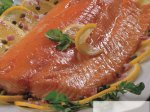BY BRYAN ROOF
Glazed salmon usually falls victim to the harsh heat of the broiler. We turned down the heat to bump up the flavor.
glazed salmon
serves 4
note: use center-cut salmon fillets of similar thickness so that they cook at the same rate. The best way to ensure uniformity is to buy a 1 1/2 – to 2-pound whole center-cut fillet and cut it into 4 pieces. prepare the glaze before you cook the salmon. if you nonstick skillet isn’t ovensafe, sear the salmon as directed in step 2, then transfer it to a rimmed baking sheet, glaze it, and bake it as directed in step 3.
- 1 teaspoon light brown sugar
- 1/2 teaspoon kosher salt
- 1/4 teaspoon cornstarch
- 4 center-cut skin-on salmon fillets, 6 to 8 ounces each (see note) ground black pepper
- 1 teaspoon vegetable oil
- 1 recipe glaze (recipes follow)
- adjust oven rack to middle position and heat oven to 300 degrees. combine brown sugar, salt, and cornstarch in small bowl. pat salmon dry with paper towels and season with pepper. sprinkle brown sugar mixture evenly over top of flesh side of salmon, rubbing to distribute.
- heat oil in 12-inch ovensafe nonstick skillet over medium-high heat until just smoking. place salmon, flesh side down, in skillet and cook until well browned, about 1 minute. using tongs, carefully flip salmon and cook on skin side for 1 minute.
- remove skillet from heat and spoon glaze evenly over salmon fillets. transfer skillet to oven and cook until center of thickest part of fillets registers 125 degrees on instant-read thermometer and is still translucent when cut into with paring knife, 7 to 10 minutes. transfer fillets to platter or individual plates and serve.
1. soy-mustard glaze
makes about 1/2 cup
note: Mirin, a sweet Japanese rice wine, can be found in Asian markets and the international section of most supermarkets.
- 3 tablespoons light brown sugar
- 2 tablespoons soy sauce
- 2 tablespoons mirin (see note)
- 1 tablespoon sherry vinegar
- 1 tablespoon whole grain mustard
- 1 tablespoon water
- 1 teaspoon cornstarch
- 1/8 teaspoon red pepper flakes
whisk ingredients together in small saucepan. bring to boil over medium-high heat; simmer until thickened, about 1 minute. remove from heat and cover to keep warm.
2. pomegranate-balsamic glaze
makes about 1/2 cup
- 3 tablespoons light brown sugar
- 3 tablespoons pomegranate juice
- 2 tablespoons balsamic vinegar
- 1 tablespoon whole grain mustard
- 1 teaspoon cornstarch
- pinch cayenne pepper
whisk ingredients together in small saucepan. bring to boil over medium-high heat; simmer until thickened, about 1 minute. remove from heat and cover to keep warm.
3. Asian Barbecue Glaze
makes about 1/2 cup
- 2 tablespoons ketchup
- 2 tablespoons hoisin sauce
- 2 tablespoons rice vinegar
- 2 tablespoons light brown sugar
- 1 tablespoon soy sauce
- 1 tablespoon toasted sesame oil
- 2 teaspoon Asian chili-garlic sauce
- 1 teaspoon grated fresh ginger
whisk ingredients together in a small saucepan. bring to boil over medium-high heat; simmer until thickened, about 3 minutes. remove from heat and cover to keep warm.
4. Orange-Miso Glaze
makes about 1/2 cup
- 1/4 cup juice plus 1 teaspoon finely grated zest from 2 oranges
- 2 tablespoons white miso
- 1 tablespoon light brown sugar
- 1 tablespoon rice vinegar
- 1 tablespoon whole grain mustard
- 3/4 teaspoon cornstarch
- pinch cayenne pepper
whisk ingredients together in small saucepan. bring to boil over medium-high heat; simmer until thickened, about 1 minute. remove from heat and cover to keep warm.
science WHITE, OUT
what’s the white stuff that sometimes mysteriously form on salmon and sometimes doesn’t? this film is a protein called albumin. when the muscle fibers in the fish are heated, they contract, pushing the moisture-filled albumin to the surface of the flesh. once this protein reaches temperatures between 140 and 150 degrees, its moisture is squeezed out, and it congeals and turns white. not only does the white albumin detract from the salmon’s appearance, but its formation indicates a loss of moisture in the fish.
cooking salmon at a low temperature can mitigate albumin coagulation. gentle cooking results in less intense muscle contractions, so that less of the albumin moves to the surface of the fish and more of it stays trapped in the flesh. the fish not only stays more moist, but it looks better, too.
source: cook’s illustrated February 2011



Very efficiently written information. It will be beneficial to everyone who usess it, including me. Keep doing what you are doing – for sure i will check out more posts.